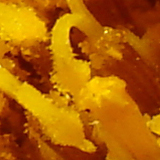Sony DSC-M1: Good Video, Disappointing Pictures
by Stephen Caston on June 20, 2005 12:05 AM EST- Posted in
- Digital Camera
General Image Quality
For these pictures, the camera was reset to its factory default setting. Then, it was set to its highest quality recording setting. The pictures were then taken in Auto mode unless stated otherwise. Portrait-style images have been rotated using Irfanview's "lossless operations". Click on a thumbnail to view the full-size image. All images are in sRGB color space.  Click to enlarge. |
 Click to enlarge. |
 Click to enlarge. |
 |
 |
 |
 Click to enlarge. |
 Click to enlarge. |
 Click to enlarge. |
 |
 |
 |
Overall, the image quality of the DSC-M1 is fairly average. In the first two samples above, the M1 demonstrates that it is capable of capturing a decent amount of detail. However, the details are characterized by a fuzzy and muddy appearance. In both pictures, even though the subjects are in focus, the details appear very soft. In the third and fourth samples, the M1 reveals another common problem - JPEG artifacts. We were pretty surprised to see this considering the relatively large file sizes. Although we spotted JPEG artifacts more frequently in shadow areas, they are also visible along fine details in nearly every picture that we took. In the fifth sample, the M1 proves capable of taking very detailed macro shots through the use of the Magnifying Glass mode. In the final sample, we used the ordinary Macro mode. Although the flowers are in focus and aesthetically pleasing, it is also very obvious that the camera has oversaturated the red channel causing clipping. We recommend shooting in Program mode where the saturation can be adjusted. Again, we weren't incredibly impressed with the image quality of the DSC-M1. However, we were happy to see that there were no real problems with purple fringing or jaggies. Most people will find the image quality of this camera acceptable for prints up to 8x10", but anything larger and you will probably notice the soft details and JPEG artifacts.
Twilight mode
 (ISO 100, 1 sec., f/3.5) Click to enlarge. |
 |
In Twilight mode, the M1 is limited to maximum exposures of 2 seconds. In our 1-second exposure above, the M1 proves that it can capture a significant amount of detail. However, just as we found with our daylight images, the details are soft/fuzzy. Again, we are surprised to see so much noise at ISO 100.
Movie Mode
 (640x480, 30 fps) Click to view. |
We recommend using VLC to play this file if you are having difficulties viewing it.
As you can see by our sample clip, the image quality is pretty good. However, the real advantage that the M1 has over traditional MPEG-1 videos is the size of the resulting file. The M1 sample video file is only 4.98 MB (14 seconds) compared to the 18.5 MB (10 seconds) file size that we saw on the Canon SD300. With our 512 MB Pro Duo card installed, the M1 indicates that we have 21 minutes and 41 seconds of video available at 640x480 and 30 fps. In addition to the option to use the optical zoom while recording, you can also select the white balance, exposure compensation, and image effects (B&W and Sepia) for video clips.










21 Comments
View All Comments
Gatak - Monday, June 20, 2005 - link
The video is 29.97 FPS. This seem to be rather odd to me. Is it the raw video or did someone convert it? Why would a camera record at 29.94 instead of 30? Makes no sense at all. It would also be nice if it was possible to choose FPS from 1 per x minute up to 30fps. That could make it really useful.yacoub - Monday, June 20, 2005 - link
It's amazing how obnoxious society is becoming. Just use a phone as a phone, or a communication device as a communication device (phone, email, txt msg'ing). All this camera and video stuff is ugh.PrinceGaz - Monday, June 20, 2005 - link
#7- I think some people just look at the pictures and don't bother reading the article.Personally I like products that use AA batteries because you don't have to buy an expensive proprietary battery as a backup or when the included one fails. NiMH AA cells have capacities of as much as 2300mAh so battery life isn't a problem-- if anything products using AA cells normally have a longer battery life than those using small proprietary batteries (such as the 680mAh capacity of the DSC-M1's battery). The other advantage of AA cells is that in an emergency you can always buy a couple of alkalines and use them, though that should only be as a last resort.
I think the main problem of the DSC-M1 is it uses Sony's Memory Stick for storage rather than the cheap and industry standard SD cards. Stupid Sony.
sxr7171 - Monday, June 20, 2005 - link
Far from me to defend an all in one Sony product but has anyone actually read the article or looked at some of the pictures at least? The AA battery was just for size comparison, it uses a Li-Ion battery. I knew this thing was a piece of crap regardless of "Carl-Zeiss" being written on the lens. It's all a stupid marketing gimmick like having a so-called Mark Levinson stereo in your car. Most Mark Levinson systems cost more than the stupid Toyota.stephencaston - Monday, June 20, 2005 - link
Thanks for the comments guys. I think I've fixed the link problems.Johnmcl7 - Monday, June 20, 2005 - link
Yeah, the image links are messed up, they include the paragraphs below.Interesting read, I'm not much of a video fanatic but I do like to recored the occasional clip, I'm currently using a Fuji S7000 which records at 640x480 and 30 frames per second, but as mentioned in the article it's mpeg-1 so it takes vast amounts of space, something like a meg per second, giving me only 15 minutes recording on a 1GB card. I look forward to mpeg4 recording becoming standard.
I use the camera attachment for my Archos AV340 which records straight to mpeg4, more than happy with the quality and there's plenty of room for the recorded movie. Unfortunately the device is in for repair, very much missing this ability on my digital cameras.
John
JustAnAverageGuy - Monday, June 20, 2005 - link
Kind of messed up the image links on the first, second, and ninth pages. No?sprockkets - Monday, June 20, 2005 - link
either that or use proprietary batteries. At least you can use ni-mh but they won't last long probably in digital cameras.Locut0s - Monday, June 20, 2005 - link
I'm always wary of products that try to be all things to all people, or simply integrate a number of different functions together. More often than not you end up with a product that does everything OK but no one thing great. Or does one thing great but the rest of the stuff feels like an afterthought. I also dislike products that use AA batteries, my experience is that they eat them for lunch. I also hate wasting them.Still I suppose there is a place for these types of products for those for whom owning an ALL-IN-ONE product trumps quality issues.
Boonesmi - Monday, June 20, 2005 - link
i want one